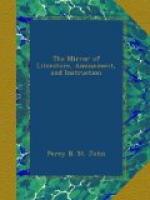[8] There is nothing so improbable in the story of Romeo and Juliet as to make us doubt the tradition that it is a real fact. “The Veronese,” says Lord Byron, in one of his letters from Verona, “are tenacious to a degree of the truth of Juliet’s story, insisting on the fact, giving the date 1303, and showing a tomb. It is a plain, open, and partly decayed sarcophagus, with withered leaves in it, in a wild and desolate conventual garden—once a cemetery, now ruined, to the very graves! The situation struck me as very appropriate to the legend, being blighted as their love.” He might have added, that when Verona itself, with its amphitheatre and its Palladian structures, lies level with the earth, the very spot on which it stood will still be consecrated by the memory of Juliet. When in Italy, I met a gentleman, who being then “dans le genre romantique,” wore a fragment of Juliet’s tomb set in a ring.
It is in truth a tale of love and sorrow, not of anguish and terror. We behold the catastrophe afar off with scarcely a wish to avert it. Romeo and Juliet must die: their destiny is fulfilled: they have quaffed off the cup of life, with all its infinite of joys and agonies, in one intoxicating draught. What have they to do more upon this earth? Young, innocent, loving, and beloved, they descend together into the tomb: but Shakspeare has made that tomb a shrine of martyred and sainted affection consecrated for the worship of all hearts,—not a dark charnel vault, haunted by spectres of pain, rage, and desperation.
The poem, which opened with the enmity of the two families, closes with their reconciliation over the breathless remains of their children; and no violent, frightful, or discordant feeling, is suffered to mingle with that soft impression of melancholy left within the heart, and which Schlegel compares to one long, endless sigh.
“A youthful passion,” says Goethe, (alluding to one of his own early attachments), “which is conceived and cherished without any certain object, may be compared to a shell thrown from a mortar by night: it rises calmly in a brilliant track, and seems to mix, and even to dwell for a moment, with the stars of heaven; but at length it falls—it bursts—consuming and destroying all around even as itself expires.”
* * * * *
PALACE OF CHARLEMAGNE, AT AIX-LA-CHAPELLE.
At Aix-la-Chapelle, situated nearly in the centre of his vast dominions, and in a salubrious climate, Charlemagne had fixed upon a spot for building a palace, in the neighbourhood of some natural warm baths,—a Roman luxury, in which the Frankish monarch particularly delighted. All that the great conception of Charlemagne could devise, and the art of the age could execute, was done, to render this structure, and the church




